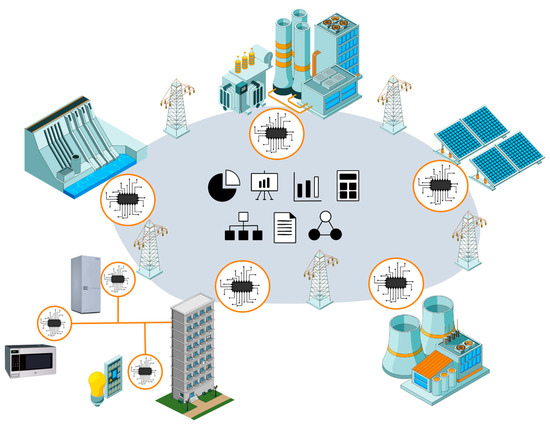1. Introduction
Energy monitoring is a vast field of research. A significant portion of the work presented in different Special Issues of
Energies assumes or anticipates the existence of energy consumption data, which attests to the importance of work in this field. The diversity of work submitted to this Special Issue demonstrates the field’s heterogeneity, ranging from in-household electricity monitoring [
1], which needs to consider not only the technical aspects of sensing but also the social and human factors of building occupants, to work focused on monitoring and improving the operation of large-scale thermal power plants (TPP) [
2,
3]. At the other end of the energy scale, Azevedo and Santos presented a process to improve the efficiency of a low-energy sensor network.
2. Special Issue Contributions
In most research, there comes a time when it will need to be validated within its target scope. That means bringing the research from the lab to the real world. In the field of energy monitoring, this often means interventions in, for example, buildings, offices, factories, or households. Quintal et al. [
1] presented the challenges of a 36-month, real-world, electricity monitoring study with prosumers of electricity. The authors presented a commercial and custom-built hardware/software monitoring approach. This work reveals that, when working in the real world, especially in the field of electricity monitoring, it is crucial to develop flexible solutions that can adapt to different building characteristics and monitoring needs. Since this equipment frequently needs to be retrofitted into the existing infrastructure, likewise, all of the papers published in this Special Issue had to, to an extent, retrofit the monitoring equipment into the existing infrastructure. The work by Quintal et al. [
1] not only focused on the technical aspects of real-world energy monitoring but also studied the human side of in-the-wild energy monitoring research within the spectrum of household electricity monitoring. This is perhaps the most interesting result of their work. The authors highlight lessons learned from working in this environment, such as examining the installation before the study but mainly that the team employed specialized human resources to follow individuals affected by the research, answering their questions and doubts and serving as a communication point with the rest of the research team.
TPPs are crucial for the modern electricity grid, the efficiency gains obtained at the production end affect all consumers and are, therefore, impactful. However, this equipment is constantly challenged by shifts in demand, especially in a modern grid with significant penetration of renewable energy. Such phenomena result in stress in all of the components of the Internal Combustion Engines part of the TPP. Vilas Boas et al. [
3] proposed an approach to monitoring the power plant, based on a statistical model based on Statistical Process Control and adapted Nelson Rules. The model was complemented by a set of visualizations for the power plant personnel. The proposed approach was validated in an event that happened in a Brazilian thermal power plant. The authors reasoned that their methodology, which continuously monitors the stress level of the TPP, will alert the operators through activation of the Nelson Rules even if the alarms limits of the TPP are not triggered, ultimately resulting in a more efficient operation of the TPP.
Also within the scope of studying the operation of TPP, Assuncao et al. [
2] developed a small-scale laboratory for training and research on TPPs. The authors used a small engine with a set of resistive loads to study the operation of larger TPPs in the lab. This apparatus had to be adapted to manage the study of different parameters during the ICE operation, which encompassed the adaptation of Thompson valves to smaller ICEs, the installation of an in-cylinder pressure sensor, the development of an angular velocity and position sensor, and the development of a rocker arm sensor. All of the sensors were tested within the proposed laboratory setting against commercial solutions in pre-defined scenarios: faulty injector, load variations, and loose clearance at the air inlet valve. The authors also studied the noise in the readings between the proposed approach and a commercial solution. The authors concluded their study by increasing the flexibility of laboratory testing and by recalling that the proposed approach resulted in similar or better results when compared with commercial equipment in the proposed test bed.
Azevedo and Santos [
4] studied the energy efficiency of a proposed monitoring infrastructure. The work was adjacent to the field of energy monitoring. It is, however, quite relevant and often overlooked since the energy cost of monitoring cannot be ignored. The authors developed a sensor network for a home monitoring system to measure energy consumption and air quality. The authors highlight that the sensing network, needs to be powered. According to the authors, this could be accomplished using alkaline or rechargeable batteries. Both of these approaches need human intervention to replace the batteries, which could cause unexpected human errors and data loss. Another alternative is the use of a local grid to power the monitoring equipment. This approach is, of course, not always possible, especially in an outdoor system. Consequently, the authors also studied a hybrid approach in which a battery was installed in each sensing node and the equipment was then connected to the local grid. An approach complemented by solar installation was also studied. In general, the proposed solution, which encompasses intelligent charging and discharging of the batteries in each node, increased the system’s efficiency from 36% to 56%.





